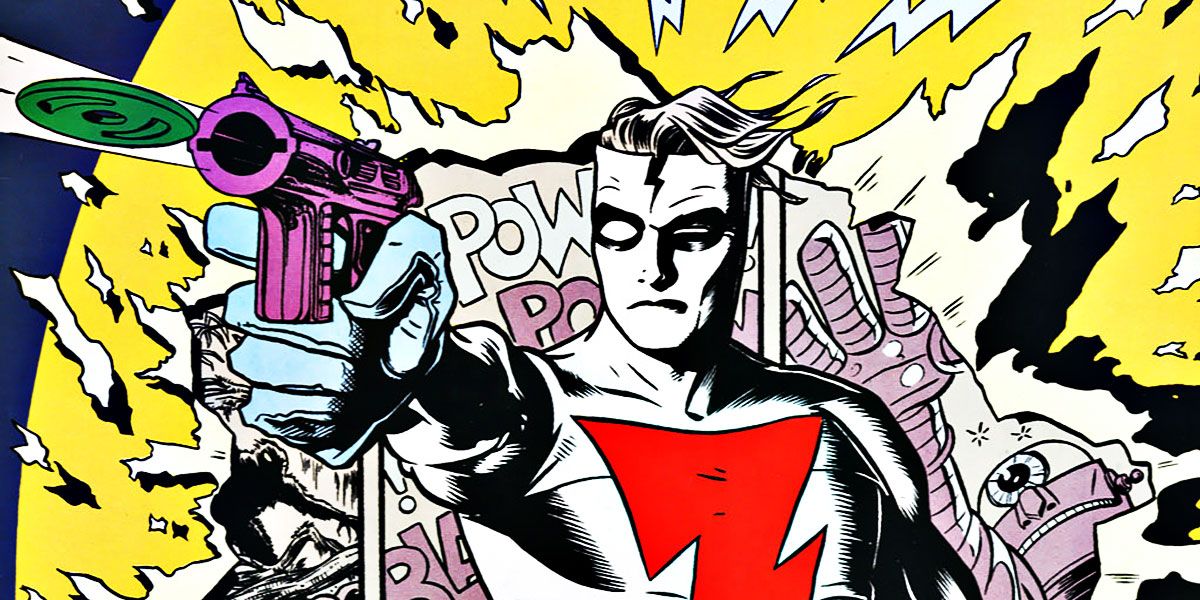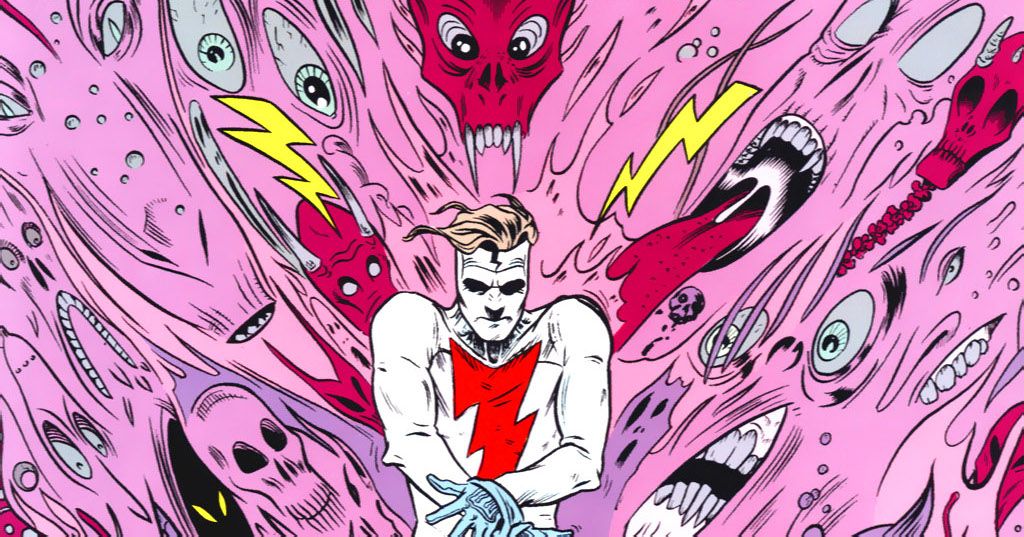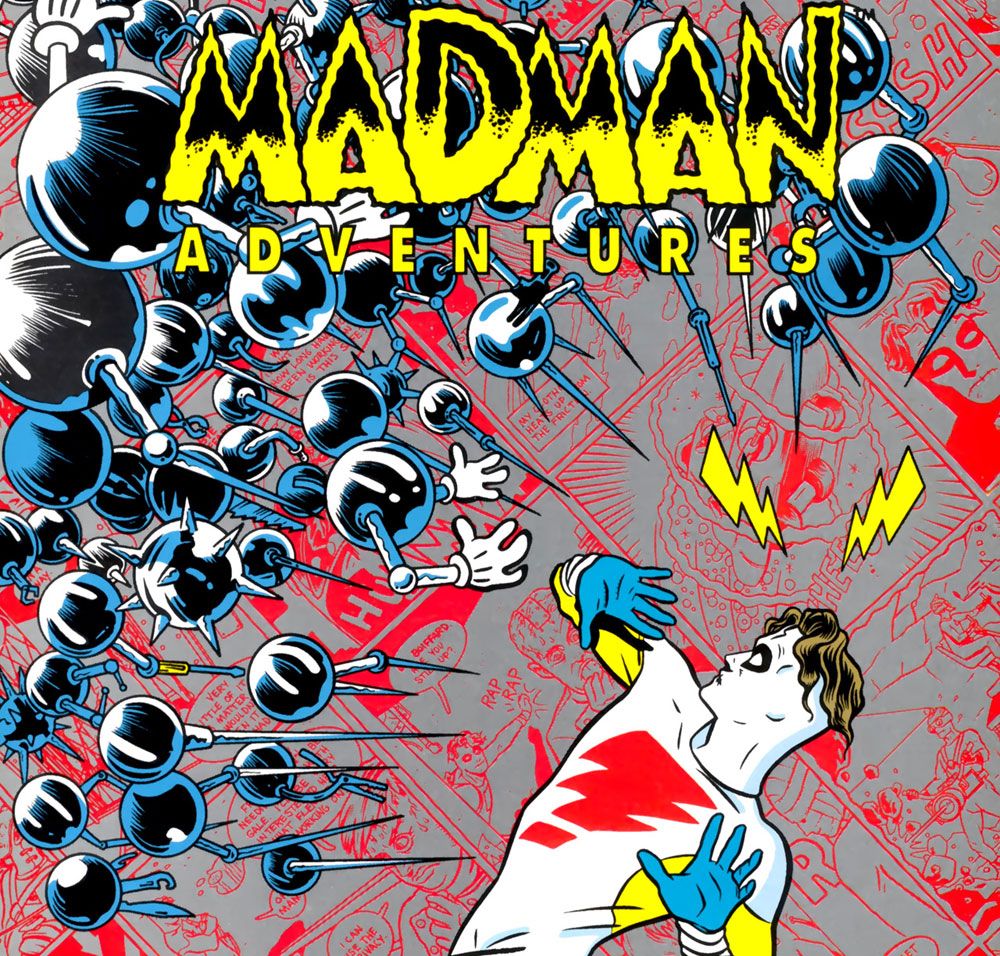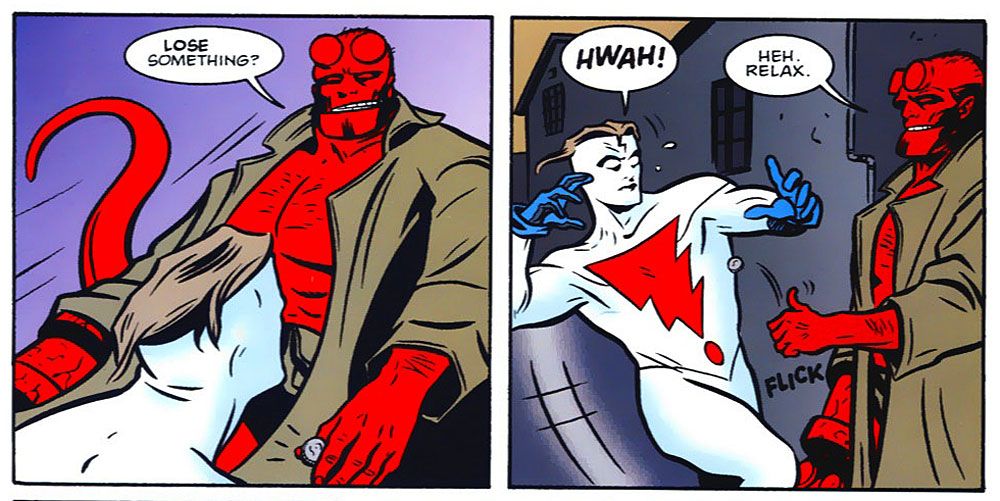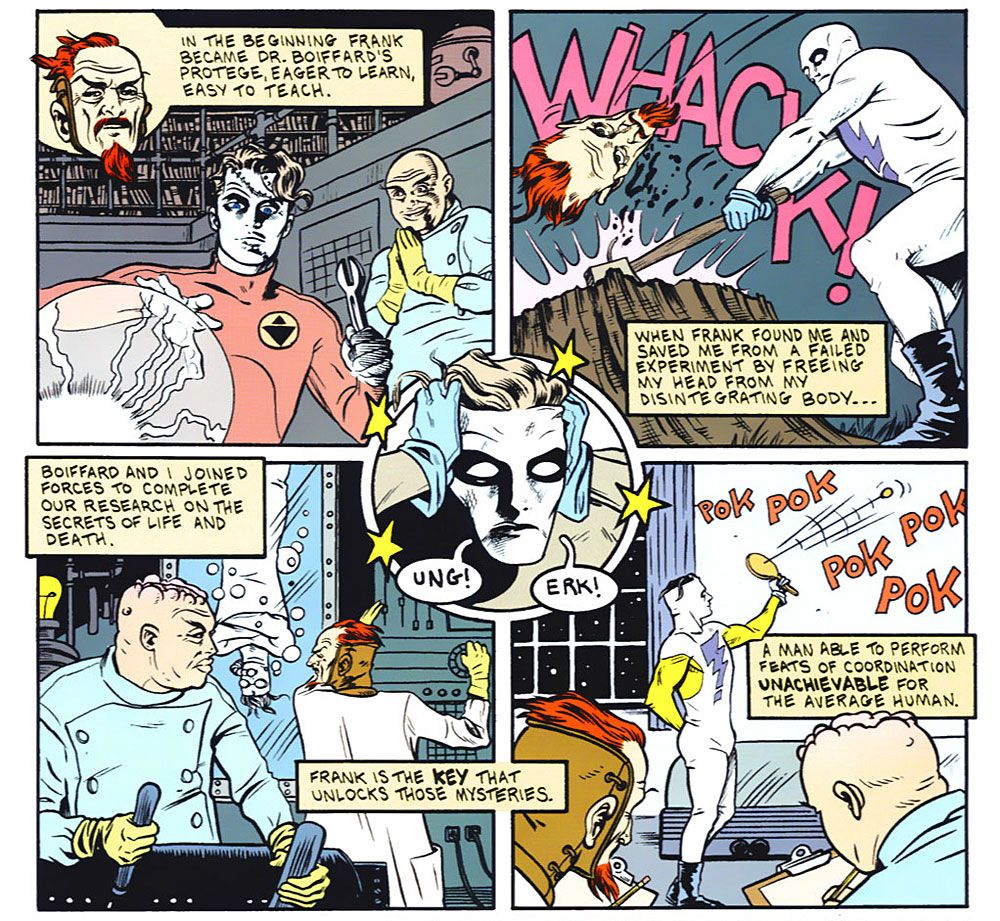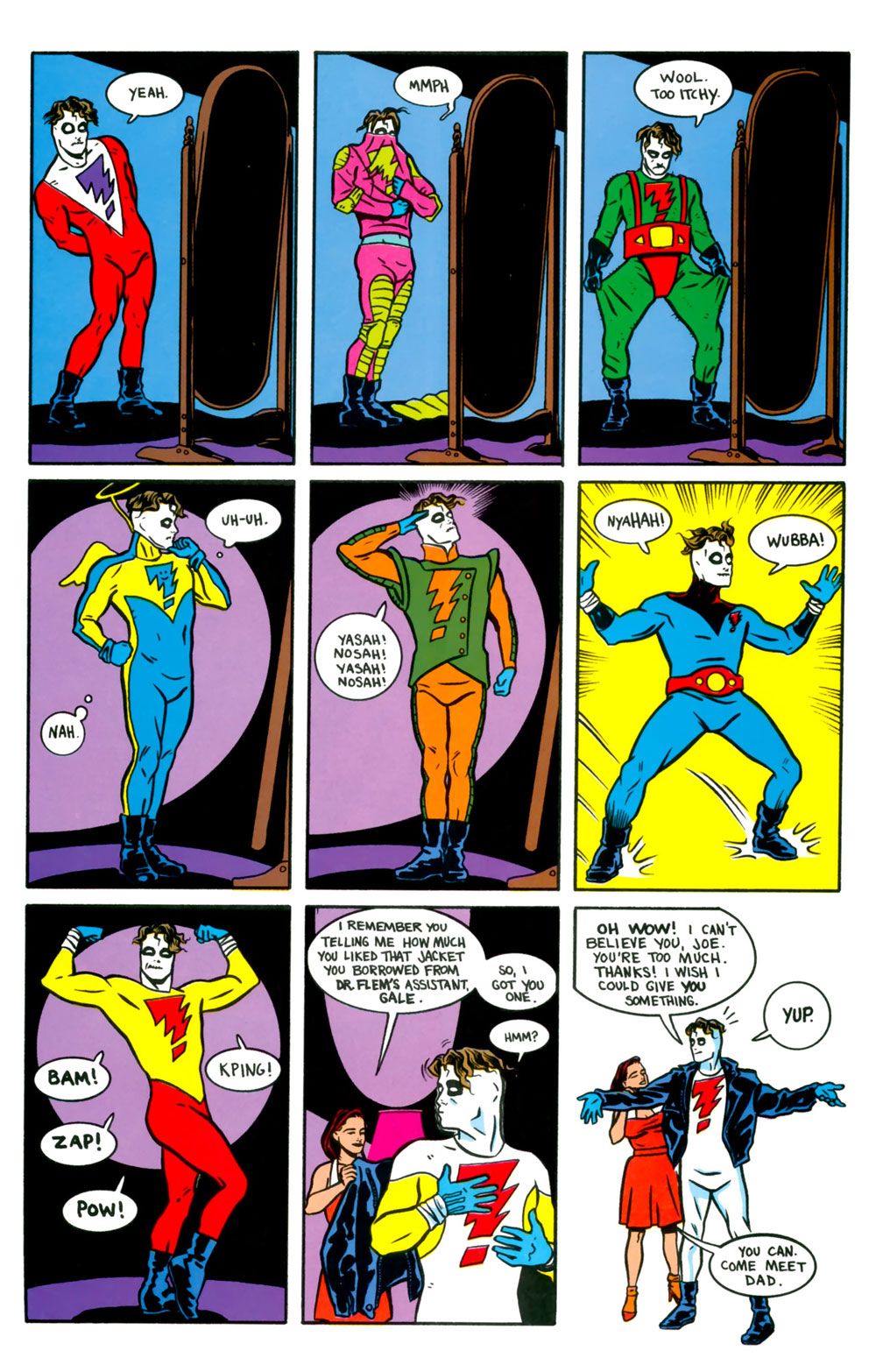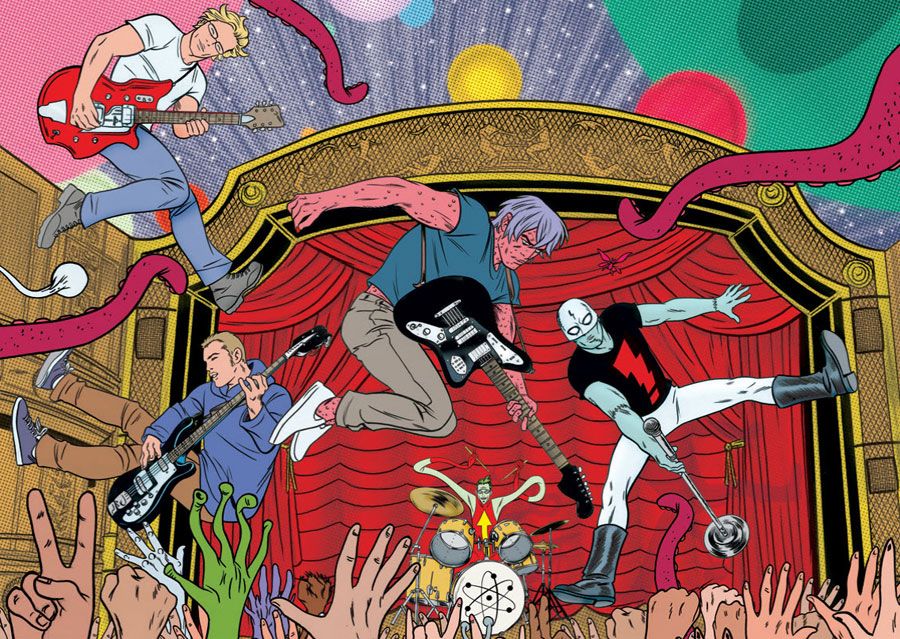1992 was a big year for comics. Seven big name creators, tired of working under the corporate machine of publishers like Marvel and DC Comics, combined their talents to form their own publishing company: Image Comics. In that year alone, the nascent publisher launched WildC.A.T.S, Youngblood, Savage Dragon and Spawn, with the first issue of the latter title selling over million copies.
RELATED: The Allreds Explore Rebirth’s Kirby-Verse in Bug! Adventures of Forager
Of course, 1992 also saw the first issue of another new costumed hero: Michael Allred’s pulp-infused, pop-art inspired, retro-throwback series, Madman!
Secret Origins!
Dressed in all-white and rocking a red logo that combined an exclamation mark and lightning bolt (A.K.A. the Exclamation Bolt!), the first Madman series followed the eponymous hero on a journey to find Dr. Gillespie Flem, the only person who can help Madman resurrect his recently deceased friend, Dr. Egon Boiffard. Armed with superhuman reflexes and the ability to take a psychic reading of someone by touching them, he faced crime bosses, a murder plot to kill a town’s mayor and deranged mutated clones. In the final issue of the series, we learn that Madman’s mask isn’t used to conceal his secret identity but to hide his scarred and discoloured face! It turns out Madman’s secret origin is that he’s actually a John Doe brought back to life by Dr. Boiffard and given the name Frank Einstein (named after Boiffard’s two idols, Frank Sinatra and Albert Einstein, while also an obvious pun).
For the record, Madman’s first appearance wasn’t actually in 1992. The character debuted in the one-off anthology Creatures of the Id in 1990, and popped up again in the Grafik Muzik miniseries. However, unless you’re a completist these series aren’t essential to the Madman canon. It’s clear from the beginning, though, that Allred had a strong connection to the character and clearly wanted to do something with him.
That something would be the monochromatic limited series Madman and the full-color Madman Adventures, both of which were published in 1992 and were colored by Allred’s wife, Laura. While Madman didn’t exactly match the million-copy selling popularity and broad appeal of books like Spawn or Youngblood, it wasn’t without fans or attention.
At the 1993 Harvey Awards, Allred received a “Best Cartoonist” nomination, with Madman winning “Best New Series.” At the following year’s awards, Allred would receive nominations for “Best Artist”, “Best Cartoonist” and “Best Single Issue” (Madman Adventures #3), while Laura was nominated for “Best Colorist.” Allred was also nominated for a couple of awards at the 1993 Eisners, including “Best Writer/Artist” and “Best Finite Series.”
Tundra would go out of business in 1993, but that didn’t deter Allred from continuing Madman’s story. He’d go to star in his first on-going series in 1994, Madman Comics, published through Dark Horse Comics under Frank Miller and John Byrne’s newly-minted Legend imprint. The same imprint would also put out series such as Byrne’s Next Men, Miller’s Sin City: The Big Fat Kill, Paul Chadwick’s Concrete and the line’s breakout series, Mike Mignola’s Hellboy, who has a brief cameo in Madman Comics #5!
It’s here that Allred’s creation would reach a wider audience and popularity. It’s also where Allred’s style noticeably evolved the most, as he become more confident as a storyteller with every issue. His line work got cleaner, page layouts became more interesting, and his writing more consistent. Alongside this, Laura Allred’s color became brighter, crisper, more "poppy." The series’ cast also expanded to include the alien Mott from the planet Hoople (named after the 1970s glam rock band Mott the Hoople), the Astro Boy homage Astroman, and the John Woo/Chow Yun-fat-inspired secret agent Chow Skip-Wang, who is constantly diving through the air while firing off pistol rounds and being shot with an alarming amount of enemy bullets.
Ginchy Stuff!
There’s a generalization that the '90s are the worst period of comics history. I don’t think that’s true as a whole, but I can definitely see where that idea comes from when you focus your lens specifically to Marvel and DC’s out-put. The X-Men were hit with crossover event after crossover event, while legacy characters were either taken out of the spotlight or straight up killed in long running storylines like “Knightfall,” “The Death of Superman” and “The Clone Saga.” Not all of these stories are bad, but it’s easy to understand the fatigue felt by readers at the time as their comics became increasingly gimmick-laden. Off the page you also had to contend with the speculator market, which was constantly on the hunt for the new Action Comics #1, buying up limited-edition die-cut covers and almost bankrupting the entire industry.
I bring this up because even now Madman feels like a breathe of fresh air for the superhero genre. You can tell just how much fun Allred is having while creating the series, and how much love he’s pouring into it. Some of his writing has aged well – the first Madman series feels a bit clunky at times, but for the most part they hold up pretty well, especially the Dark Horse run.
It’s a comic where people describe things as “ginchy” (1930s slang for cool), and it doesn’t feel out of place. Allred has an affinity for the past; his clean style owes a lot to Jack Kirby and Alex Toth’s art, and he regularly dips his toes into pulp fiction: aliens, robots, shady G-Men from Hell! On more than one occasion, Einstein runs into a gang of Street Beatniks who’ll confuse you with the bizarre slang of yesteryear before beating you up.
Allred also embraces the sheer ridiculousness of comics. Madman has to decapitate Dr. Flem and reattach his head to a clone of his body, while Felm’s assistant Gale tries to use chemically-treated bandages to remove tattoos that are covering her entire body, but instead makes herself totally invisible except for the tattoos. Dr. Boiffard repeatedly injects himself with a brain enhancement formula until he becomes a giant floating brain. Each issue of the original Madman series included drawings in the bottom corner of the page that you could flip through to make a short animation.
Madman’s set up – a dead man brought back to life who now fights crime – is one that easily could’ve taken a much more grittier and darker route. It’s basically Spawn’s origin, the book that defined the grimmer superhero comics of the '90s. With a premise like that, it could’ve also have been a macabre contemplation of man’s morality or post-modernist experiment, similar to what authors like Neil Gaiman and Grant Morrison were writing over at Vertigo. And yet, the darkest Madman gets is in the first couple pages of the original Tundra run, when Frank rips out a hired goon’s eye and eats it. (He feels bad about it later.)
But what ultimately set Madman apart from a lot of the other popular superhero books that were coming out at the time, with their edgy, grungy, “These ain’t your daddy’s superheroes!” aesthetic, was how effortlessly cool it was. Madman is cool in the same way as David Bowie or the Velvet Underground are cool -- you don’t know how to explain why, they just are. Einstein regularly wears a leather jacket over his costume, and you never really question the look, while the bomber jackets being worn by the X-Men and Avengers at the same time came off as extremely dorky.
Overall, Madman was a celebration of just how imaginative and weird comic books can be. Madman’s costume is one of those simple but brilliant designs in comics, and each issue is filled with this energy as Allred goes for broke, channelling his love for 1950s sci-fi pulps, 1960/70s glam rock and the dynamic energy of Jack Kirby. It was fun, but still managed to tackle big concepts like identity and existence as Einstein tries to unravel the mystery of who he was before he died.
Madman & Beyond!!
Frank Einstein would go on to appear in a spin-off series The Atomics (a super team consisting of mutated Street Beatniks turned good guys), a second on-going Madman Atomic Comics (now published through Image), a handful of one-shots between 2009 and 2014 and a coffee-table sized 20th anniversary hardcover.
It’s been a couple of years since Madman’s Exclamation Bolt graced comic store shelves, which is understandable considering that Allred has been busy with art duties on Vertigo’s iZombie, Marvel’s FF and Silver Surfer, and is currently writing and drawing Bug!: The Adventures of Forager over at Young Animal (With Laura on colours and his brother Lee co-writing). On Twitter he’s hinted at a 25th Anniversary Special that's should be coming out sometime later this year, so here’s hoping for the return of the World’s Snappiest Comic Magazine!

